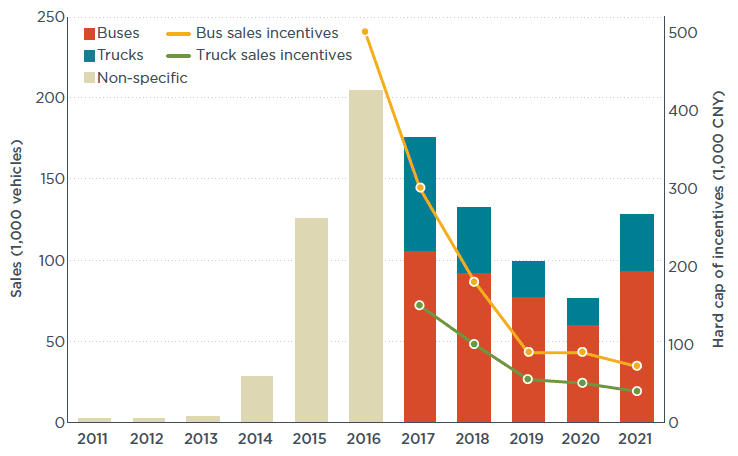Working Paper
Zero-emission bus and truck market in China: A 2021 update
点击此处查看中文内容
A full transition to zero-emission heavy-duty vehicles (ZE-HDVs) is essential if China is to meet its decarbonization goals. The ZE-HDV market in China saw rapid growth in the past decade and ZE penetration of China’s domestic HDV market reached 4% in 2021. That growth was uneven, however: With the COVID-19 pandemic outbreak at the end of 2019, the automobile industry tumbled, and the ZE-HDV market posted its weakest performance since 2014. However, the ZE-HDV market recovered in 2021, the year on which this study focuses.
The market for zero-emission trucks and buses reached 130,000 units sold in 2021. (Figure.) These volumes are comparable to those in 2018 when subsidies were two and a half times greater. This decoupling of sales volumes and state subsidies is an encouraging sign, signaling the beginning of an independent and robust market for zero-emission heavy-duty vehicles.

Figure. Total sales of ZE-HDVs from 2011 to 2021
While subsidies from the central government are important, the market is also driven by the increasing availability of ZE-HDVs, decreasing cost of ZE-HDVs, increasing awareness of the benefits of ZE-HDVs, and increasing number of provinces and cities that are launching pilots and adopting policies to promote the deployment of ZE-HDVs.
The paper finds that:
- The zero-emission truck race is reshuffling the market positioning of China’s HDV behemoths
- Buses dominate the ZE-HDV market, but electric trucks are on the rise
- National subsidies play a role in picking winners and losers
- Battery suppliers are heavily consolidated, with CATL providing nearly 50% of the batteries in China’s ZE-HDVs
- Buses have more advanced battery technology than trucks, while using the same battery chemistry
- Fuel cell powertrains are at a nascent stage
- Battery-swapping powertrains are skyrocketing in response to policy support.
